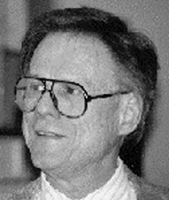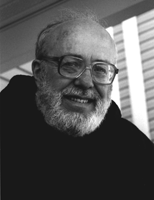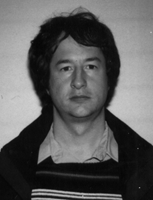A SIAM Tradition Goes Online
March 22, 1999

SIAM Review's Problems and Solutions section, says long-time editor Cecil Rousseau, "has brought about productive contacts between proposer and solver that probably would not have taken place otherwise." Counting himself among those whose research has been enriched by such contacts, Rousseau is continuing to edit the section in its new, all-electronic format.
Over the years, nearly 800 problems, on a variety of topics, have appeared in Problems and Solutions, according to long-time section editor Cecil C. Rousseau, a professor at the University of Memphis. "The Problems and Solutions section has placed special emphasis on problems of an applied nature," he says. "Of the hundreds of problems published, a great many have come from chemistry, physics, engineering, medicine, and various other fields, and this has helped to give the section its special character." "Other problems," he adds, "have merited publication on the basis of intrinsic mathematical interest, or because they are so attractive and give the solver such a great opportunity to test his or her ingenuity." Although some problems do remain unsolved, solutions to most were published in the journal after competitive review.
Trying to solve these problems has benefited devotees of the section in several ways. "Since many of the problems have come from professionals in diverse fields," Rousseau explains, "the section has brought about productive contacts between proposer and solver that probably would not have taken place otherwise." Rousseau notes that he personally benefited from connections created by the Problems and Solutions section. The publication of a graph coloring problem by Paul Erd�s in the April 1972 issue led to a collaboration between Erd�s and members of the graph theory group at Memphis (including Rousseau, Ralph Faudree, and Richard Schelp) that covered more than 20 years.
Rousseau points out that problem solvers at all levels have been able to enjoy the Problems and Solutions section. "The section has provided an opportunity for students and younger professionals to find interesting problems, and to have their solutions published," he adds.
Solving problems can be satisfying and rewarding, says Otto G. Ruehr, a professor emeritus at Michigan Technological University, a member of the Problems and Solutions editorial board for more than 20 years and co-editor of the section, with Cecil Rousseau, from 1994 to 1998. For Ruehr, who remains a fan of a printed format for the highly regarded section, "Part of the challenge of editing Problems and Solutions is finding the right balance both in the kind of mathematics and the degree of difficulty of problems for each issue." He feels that "it would have been preferable to keep the printed version, at least for a time, while the electronic version was developed." The section was designed "to be of interest to readers at all levels," he explains, with part of its function being a way to "entertain" as well as engage members.

Ever attentive to a careful balance in both the kinds of mathematics involved and the levels of difficulty of the problems included in a particular issue, 20-year Problems and Solutions veteran Otto Ruehr has been missed since his recent retirement from the section.
"We have all been fortunate," Ruehr continues, "in our association with Murray Klamkin, who founded the section and was its editor for 35 years." Klamkin's book, Problems in Applied Mathematics---dedicated to the memory of past collaborating editors Yudell Luke and Henry Fettis and published by SIAM in 1990---provides a selection of the best problems grouped by type, prefaced by history and comments. Rousseau also expresses gratitude to Klamkin for his efforts in starting the Problems and Solutions section and shaping its emphasis and scope. Describing Klamkin as one of the world's most prolific problem posers and solvers, he points out that Klamkin, Donald Newman, and Larry Glasser have contributed the greatest number of problems to the Problemsand Solutions section. "Many expert problem solvers," Rousseau adds, "have been regular and devoted contributors."

Michael Renardy
The move to an on-line format is one that the editors hope will make the section more accessible and more interesting for SIAM members and others in the mathematical sciences. Working with a board of volunteer editors, Rousseau will continue to edit Problems and Solutions. Current members of the board are Giles Auchmuty (University of Houston), Jonathan Borwein (Simon Fraser University), Philip Korman (University of Cincinnati), Michael Renardy (Virginia Polytechnic Institute & State University), and Richard Stong (Rice University).
Editorial board members will continue to review problems posed by mathematicians in academia and industry and to post unsolved problems. Solutions will undergo the same peer-review process that was conducted for the printed format. If multiple solutions to the same problem are submitted, the editorial board will choose the best solution and forward it to SIAM for posting; other solvers will also be acknowledged.
For new board member Michael Renardy, several of whose solutions appeared in SIAM Review over the past 15 years, the value of the section lies in its advanced content. "What distinguishes this section from other problems sections," he says," is that SIAM is not focused exclusively on undergraduate teaching; therefore, the section provides a rather unique forum to publish mathematical 'puzzles' at a fairly advanced level, including problems that relate to real applications. I think many mathematicians enjoy working on these. I certainly did."
New editorial board member Richard Stong has had some experience with problems sections that were often more limited in scope. "I am hoping to see different sorts of problems" as an editor for SIAM, he says. "I hope to see a variety of problems, ranging from theoretical to applied, and I would like to see the audience cover the full range from graduate students to researchers in industry and academia."

Richard Stong
The section, whatever its format, is valuable to all SIAM members, says Jonathan Borwein, another incoming member of the editorial board. The traditional section "has been read and appreciated by many who never or rarely submitted solutions," he explains. "A well-produced problems section is seen by a very large number of people." Borwein hopes that the target audience will continue to include "a broad spectrum of problem solvers-from undergraduate scientists to researchers-including the section's traditional readers and new 'viewers.'" He sees the section featuring problems that will engage readers, and that will be enhanced by presentation in an electronic/computational medium.

Jonathan Borwein
For Borwein, who has various interests in electronic publishing and electronic mathematics, editing this Web-based version of a problems and solutions section will be both interesting and challenging. "I'm interested in seeing how an electronic problems and solutions section evolves," he says, " and in making the section as interactive as possible." Borwein, who contributed both problems and solutions to SIAM Review, points out that open problems have in several cases triggered his own research. "Within my own research group," he says, "we hope to put together a group to see how often the problems can be attacked using computational tools such as those that Maple, Mathematica, or more specialized resources provide."
"I am very excited that Cecil Rousseau has asked me to assist with this SIAM problems section," says new editorial board member Philip Korman. "I have contributed three problems to that section in the past, and I would always start reading [SIAM Review] at the problems section. Problem solving is fun at all stages of a mathematician's career, but I think there is nothing better than a short, clear, and challenging problem to capture a student's interest. If one reads biographies of many famous Hungarian mathematicians (Erd�s, P�lya, or Szege, for example), there always seems to be the mention of a high school problem-solving journal."
"I would like to see this electronic section develop into a community where people with mathematical problems can obtain help, advice, and possibly even complete answers to questions that arise in their work, or research," says new editorial board member Giles Auchmuty, several of whose solutions were published in the print version. "Part of the editorial task," he says, "will probably be to organize the questions and the site, as well as the more usual task of making sure all posted answers are correct. Having an electronic site should encourage people who need quick answers to post problems."
For Auchmuty, editing the section is a natural follow-up to the problem-solving that is a major part of doing applied mathematics. "I imagine the nature of the section will change considerably now," he says. "How it evolves will depend on what problems are posted and who contributes. At this stage, I'd like to encourage members to contribute problems and solutions at all levels and to bookmark the section and look at it on a regular basis to see if they can help out in resolving the posted problems."
"The main advantage of this particular problems section," reiterates Cecil Rousseau, "is the fact that it brings together people who have interesting and scientifically motivated mathematical problems with some of the most talented problems solvers around the world. This has been a main feature of the print version," he adds, "and I am confident that it will continue be the case in the electronic format." "We hope to gain a wide audience of problems enthusiasts who can contribute and solve challenging problems, and who will help to expand the scope of the section though creative uses of technology."
All problems and solutions should be sent to Cecil C. Rousseau, Department of Mathematical Sciences, The University of Memphis, Campus Box 526429, Memphis, Tennessee 38152-6429; Fax: (901) 678-2480; E-mail: [email protected].
Authors are asked to submit their problems in LaTex, if possible; authors will be informed by the editor of the decision to accept or reject problems.

